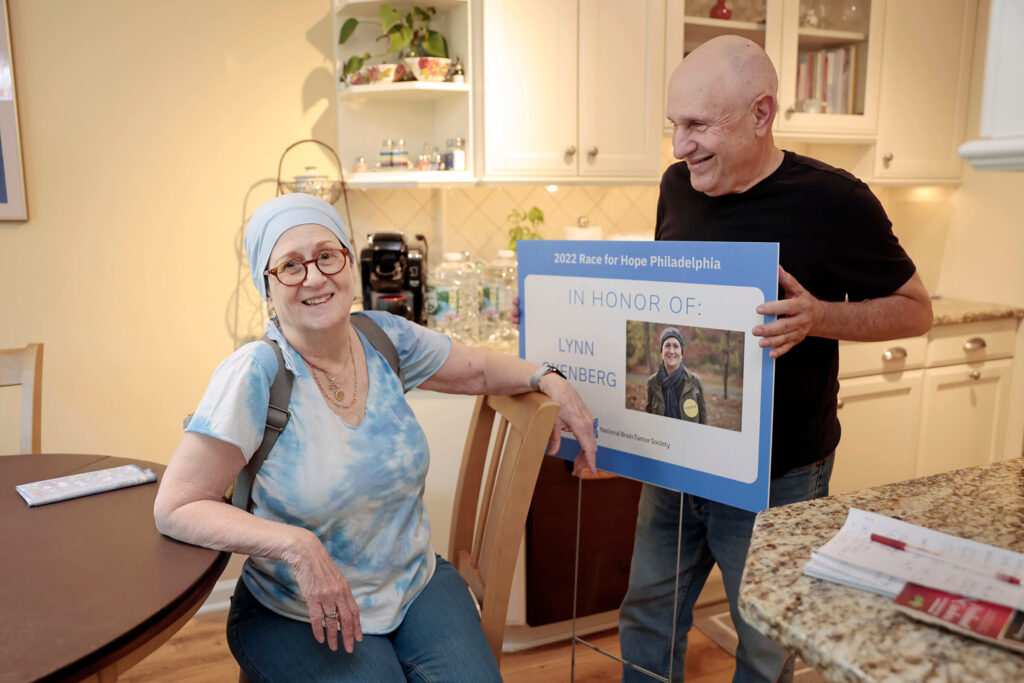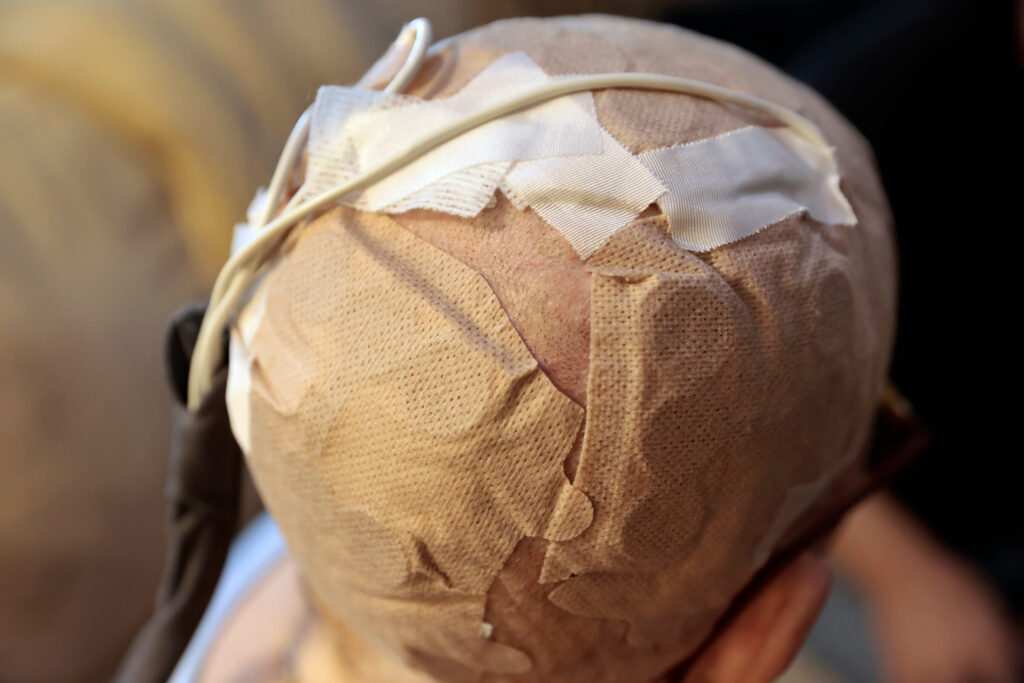Every two days, Lynn Oxenberg leans over her bathroom sink while her husband shaves the shadow of auburn hair beginning to cover her head.
Once clean shaven, she sticks to her scalp four tan patches with electrodes designed to keep aggressive cancer cells from growing in her brain.
She stuffs the protruding wires and a two-pound battery into a mini backpack, then heads to the grocery store, or library, or lunch with friends.

This has been Oxenberg’s routine for six years. It can be arduous, but it’s kept the 73-year-old Elkins Park, Pennsylvania, grandmother alive far longer than most people diagnosed with glioblastoma, an aggressive brain cancer that kills in an average of 15 months.
Penn doctors are now researching whether the treatment routine, paired with highly sensitive MRI monitoring, could one day make Lynn’s experience — living with glioblastoma for years — less of an anomaly.
There is no cure for glioblastoma, and the disease is exceptionally difficult to treat. Glioblastoma is typically treated with a combination of surgery, radiation, and chemotherapy, then monitored closely for signs the cancer is growing again. Once the cancer begins to regrow, it is almost always fatal. Surgery, chemotherapy, and radiation can never eliminate all of the cancer because glioblastoma tumors burrow into brain tissue like an octopus’ tentacles.

Penn researchers are testing whether they can help glioblastoma patients, who have already had surgery and other treatment to reduce the size of their tumor, to live longer by pairing the Tumor Treating Fields (TTF) therapy Oxenberg uses with artificial intelligence-powered MRIs that take a tumor’s “temperature” for highly precise results.
The combination departs from the standard of care for the disease. Instead of waiting for the disease to return and treating it with more chemotherapy or radiation, TTF therapy, made by Swiss pharmaceutical Novocure, constantly sends electric fields through the brain to keep cancer cells from growing. The temperature-taking MRIs can show the earliest signs that a tumor is returning, and help doctors swiftly pivot their care plan.
Suyash Mohan, Penn’s director of neuroradiology research, calls it a “whole brain” treatment that could be more effective than attempting to isolate a tumor that can never be fully eliminated. The TTF therapy keeps cancer cells in check, and the highly detailed MRIs can help make quick changes to treatment, if necessary.
Novocure’s FDA-approved TTF therapy device, Optune, has shown modest results in extending life spans for glioblastoma patients. Patients in Novocure’s phase 3 trial who wore the device 70-80% of the time lived an average of 21 months, compared to 15 months among patients who received standard treatment. But the device can be cumbersome: Patients must shave their heads to glue electrodes in place. Unlike medications that remain in the body hours or days after being taken, Optune only works when being worn.
Some cancer experts say that while the results are promising, convincing patients to take such aggressive measures can be challenging. The treatment is covered by Medicare and many commercial health plans, but costs $21,000 a month without insurance.
It’s unclear whether the approach will ever lead to a significant change in the outlook for glioblastoma patients. But Mohan thinks the work at Penn is a glimpse at the possibility that someday, one of the most notoriously aggressive cancers could be treated as a chronic condition.
“The overall survival of this disease hasn’t changed in the last 25 years,” Mohan said. “We have to reassess how we approach this tumor.”
Artificial intelligence-powered MRIs for glioblastoma
Glioblastoma is a fast-growing brain cancer most common among older adults. Treatment can slow the cancer’s growth and help manage symptoms, but there is no cure.
Patients may have surgery to remove the largest portion of the tumor, though some are too deep in the brain to access. Surgeons typically can’t remove the entire tumor — its tentacles that reach down into the folds of the brain are impossible to safely remove.
Doctors may recommend radiation or chemotherapy to kill remaining cancer cells, but because the tumor becomes so intertwined in the brain, it is difficult to target cancer cells without also killing healthy brain cells.
Doctors rely on MRI imaging to help them track whether treatments are shrinking the tumor. But some treatments cause inflammation that can look similar to a tumor on an MRI, which makes it hard for doctors to tell exactly where the tumor is.
Mohan and his colleagues developed a tool that acts as a thermometer, using artificial intelligence to give a more nuanced reading of the brain. The MRI technique uses images from the whole brain to create a real-time “temperature” that can tell doctors more precisely where a tumor is and whether it’s growing or shrinking.
Patients are scanned every two months — as often as they would be with a traditional MRI. But the results are available right away, which can reduce anxiety waiting for answers and allow doctors to make more immediate changes to patients’ treatment plans, Mohan said.
The goal is to provide more advanced MRI images that can help doctors make faster, more precise decisions about patients’ care, he said.
Disrupting glioblastoma cells with electricity
Penn is currently testing the MRI technique in a clinical trial with glioblastoma patients receiving TTF therapy. Whereas chemotherapy and radiation target specific tumor spots — with varying precision — TTF sends electrical currents through the whole brain to disrupt cancer cell growth.
Initial clinical trials for Optune found a small increase in life expectancy for patients treated with TTF therapy, and a greater likelihood of surviving up to five years.
But the demands of the treatment outweigh the potential benefits for some patients, said Stephanie Weiss, chief of the division of neurologic oncology at Fox Chase Cancer Center.
Patients must shave their head every two days to ensure the electrode pads will stick to their skin, and use a glue that can be irritating.
And because the treatment only works when the device is being worn, patients are supposed to wear it for at least 18 hours a day for two years.
“It makes a lot of sense,” Weiss said, “but I think what we’re doing right now is rudimentary.”
Novocure’s executive chairman, William Doyle, agrees there’s room for improvement. The company, which has offices in Wayne, is designing thinner head patches and exploring whether they can increase the power delivered through the patches, which would reduce the amount of time patients must wear the device.
The company is also working on an app that would help patients track how long they’ve worn the device.
Admittedly not the most stylish look, Optune’s gauze head wrap and mini backpack can make it possible for glioblastoma patients to survive long enough to make it to important family milestones, like a child’s graduation or wedding, Doyle said.
“You can live with this,” is the message the company sends patients and doctors, Doyle said.
Living with glioblastoma
Oxenberg was diagnosed in December 2017, and after she’d had surgery and as much chemotherapy as her body could tolerate, her doctor suggested she try Optune. Oxenberg agreed.
She began her treatment in April 2018 and still wears the device 90% of her day.
She was reluctant to part with the red hair that had been her identity since the maternity ward nurses paraded her around to show off the fiery fluff sticking out of the hospital’s swaddling blanket.
“I realized my hair was overrated,” she said.
It’s a trade she says she is willing to make for more time with her husband, children, and grandchildren.
Earlier this month, all 10 of them headed to North Carolina’s Outer Banks for their annual summer vacation. The sun and sea breeze felt different against her exposed scalp. And she soaked it in.
___
© 2024 The Philadelphia Inquirer, LLC
Distributed by Tribune Content Agency, LLC.



